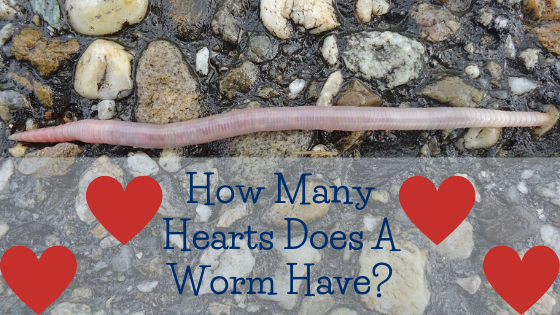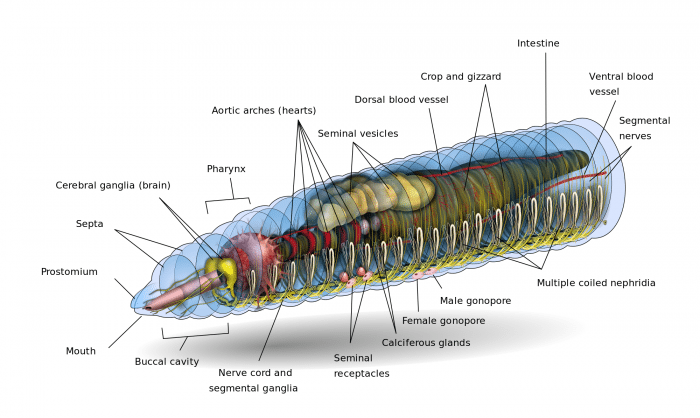
How many hearts does a worm have? Well, the answer to that question can be a bit tricky, as it depends on how you define “heart.” Depending on the definition, worms can be said to have 0, 5, or 10 hearts. While they lack a traditional heart as understood in humans, worms do have 5 pairs of aortic arches that play a similar functional role to that of the human heart.
First, a bit on the terminology “worm” Strictly speaking, “worm” is an obsolete scientific biological classification. Linnaean taxonomy classified all non-arthropod invertebrates as “Vermes”, a classification we now know to be polyphyletic; that is, a grouping consisting of organisms that are in fact not closely related.
“We are all worms. But I do believe that I am a glow-worm.” — Winston Churchill
Linnaeus’ original classification of vermes was based mostly by groupings of analogous biological structures and included some species of barnacles, jellyfish, snakes and various parasites; species very unrelated to each other phylogenetically speaking. Historically, the category of “worm” functioned as a kind of wastebin taxon; a grouping that was for leftover organisms that could not clearly be sorted into other categories. So to be more specific, we are focusing on the lumbricus Terrestris, the common earthworm.
Earthworms live all over the world, and in many places play an important role in the ecosystem by breaking down organic matter into compost form to be used by plants. There are over 1,800 species of worm considered earthworms, found on every continent except Antarctica. The United States, for example, has over 20 different native species of earthworms, and another 20 that have been introduced from Europe. They are part of the taxonomic group called Annelids, which includes other creatures like leeches and some species of aquatic worms. Like flies, they are useful in the laboratory as they are numerous and easily raised. They typically are constituted out of 100-150 individual segments (called metamerisms) and can range from a tiny 10mm long to a whopping 3m long. The largest known earthworm in the world os the Australian Gippsland earthworm which routinely reaches lengths over 9 feet.
Anatomy
Earthworm bodies consist of an inner layer of muscle, an epidermis (skin), and an outer layer of protective coating called a cuticle. Though they appear smooth and uniform, each segment apart from the mouth and the anus are covered in tiny setae—small hairs found on a number of insects. On the head segment, just above the mouth is a fleshy protrusion called a prostomium. The prostomium closes the mouth while the worm is at rest but also uses it to sense chemicals in the environment, like a tiny antenna. Adult worms grow a fleshy band called a clitellum across the most middle segments. The clitellum produces eggs and deposits them in a viscous sac of fluid.
Earthworms move by the coordinated motion of two main types of muscles. The upper layer consists of a row of circular muscles that contract, decreasing the worm’s diameter but increasing its length. The inner set of muscles is longitudinal and their contractions increase the worm’s diameter but decrease its length. So earthworm motion consists of a pattern of rhythmic contractions and elongations that slowly move it across the ground.
Strictly speaking, earthworms lack eyes. Yet, they do have a set of specialized photosensitive cells that function analogously to eyes. Likewise, they have no ears, but instead “hear” by sensing vibrations through the ground. They do not have any teeth and so do not bite or chew their food. Instead, like a snake, they slowly engulf their food as muscle contractions inch the morsels through the digestive system. The digestive system of an earthworm is a single straight tube from the mouth to anus, where food passing through is ground up and passed on to be digested by enzymes. Unlike humans, earthworms do not have not specialized excretory openings; all waste products are excreted through the anus.
“If worms have the power of acquiring some notion, however rude, of the shape of an object, and over their burrows, as seems the case, they deserve to be called intelligent; for they act in nearly the same manner as would man under similar circumstances.” — Charles Darwin
Like all invertebrates, earthworms lack an internal skeleton, but they do have a relatively complex internal structure, which makes them of interest to researchers. Primary is the central body cavity of the earthworm, known as the coelom, in which the earthworm’s various organ systems are situated. Earthworms have a nervous system with three parts, a central nervous system, the peripheral nervous system, and a sympathetic nervous system. They even have a brain like structure composed of pairs of cerebral ganglia. Earthworms also show some ability to regenerate lost segments but that capacity differs from species to species. Due to his research, the scientist G.E. Gates showed that is is possible to grow two separate organisms from bisected specimens of some earthworm species. Earthworms are hermaphroditic and contain both ovaries and testes. When mating, a pair will attach to each other front ends and each exchange sperm with the other. Sometime later, the earthworm will combine this sperm with the eggs it has grown in its clitellum and deposit these eggs in a cocoon-like incubator. Earthworms also seem to be capable of parthenogenesis, meaning that they can grow and develop embryos without fertilization.
Earthworms have a single closed circulatory system that facilitates the transmission of waste, nutrients, and fluids. This circulatory system comes complete with 5 different functioning vessels to carry blood, the dorsal, ventral, subneural and two lateroneural vessels. Unlike say a mollusk, whose blood exists en masse inside the organism’s body, earthworms channel their blood through a predefined circulatory system. The “heart” of an earthworm sits near the creature’s mouth and exists in 5 pairs of organs known as aortic arches. As the name would imply, the aortic arches are so named because they have an arch-like appearance. The aortic arches are situated around the coelom and their pumping action facilitates the transmission of blood, very similar to the action of a human heart. Think of the earthworm’s body like a rubber hose and the aortic arches like a person squeezing the hose. The pressure from contraction shunts the blood through the vessels to the appropriate areas.
Earthworms lack lugs and respirate through their skin, so they “breathe” by absorbing oxygen through their outer layer of skin. Oxygen dissolves on the mucus that covers an earthworm’s outer skin, so earthworms must remain moist to respirate properly. One they “breathe” the aortic arches contract and pump oxygenated blood through the dorsal vessel. Once the oxygenated blood has been used, the waste product carbon dioxide diffuses out of the worm back into the environment. This pumping action of the aortic arches. is functionally similar to the pumping action of a human heart. Interestingly, earthworms regulate the activity of their aortic arches via their nervous system, unlike other invertebrates that use their muscles to regulate respiration. This makes the activity of an earthworm’s aortic arches more analogous to the activity of a human heart. Aortic arches only have one chamber though, so if one defines “heart” as having multiple chambers, then an earthworm has 0 hearts. Alternatively, if a “heart” is just an organ functionally similar to a human heart, then earthworms have up to 10 hearts (or 5 pairs of hearts).

A diagram showing the internal structure of an earthworm. Source: KDS4444 via WikiCommons licensed under CC-BY-SA 4.0
Earthworms & Ecology
Earthworms play a crucial role in many ecological niches. They feed on organic matter and excrete a compost-like substance rich in nitrogen that plants use for nutrients. By digesting decaying organic material, they change the soil composition and introduce beneficial minerals and microbes. Earthworm populated soil has shown to have up to 5 times more available nitrogen, 7 times more phosphates, and 11 times more potassium than surrounding patches of soil (Brady & Weil, 2009). Their burrowing activity aerates and mixes soil, which makes it conducive for the mineralization and root uptake. Scientists have compared earthworm activity to that of pistons in a pump. Just as pistons in a pump circulate air through the pump, earthworm burrowing circulates air through the pump that is the soil.
“The early bird gets the worm. The early worm… gets eaten.” — Norman Ralph Augustine
The soil benefits of earthworms are so well known that many farmers consider them welcome guests in their gardens and agricultural industries are familiar with the eco-friendly nature of earthworm activity. Given the need for future sustainable farming techniques, earthworms could play a valuable role in future farming efforts. In addition, earthworms serve as the base for many food chains and are fed on by birds, reptile and mammals alike. Earthworms play so many beneficial ecological roles that Charles Darwin wrote in 1881, “It may be doubted whether there are many other animals which have played so important a part in the history of the world, as have these lowly organised [sic] creatures” (pg. 314).
So in summation, how many hearts does an earthworm have? Again, it depends; if “heart” is specifically defined as a multi-chamber organ with valves like it is in human beings, then an earthworm has zero hearts. However, if “heart” is defined in a more functional sense as an organ that facilitates circulation through a mechanical pumping action, then an earthworm has up to 10 individual hearts. These 10 individual “hearts” or aortic arches line the central body cavity and their mechanical pumping action facilitates the circulation of the earthworm, much like a human heart does.
References
- Brady, N.; Weil, R. [2009]. Elements of the Nature and Properties of Soils. (3rd edition). Prentice Hall.
- Darwin, Charles, R. [1881] “The formation of vegetable mould, through the action of worms, with observations on their habits.” <http://darwin-online.org.uk/content/frameset?viewtype=text&itemID=F1357&pageseq=1>









